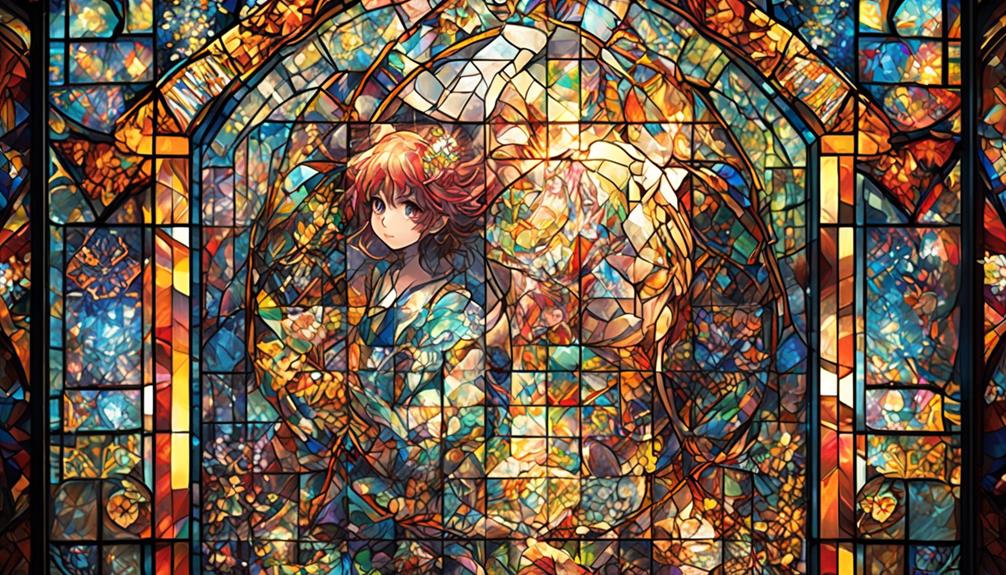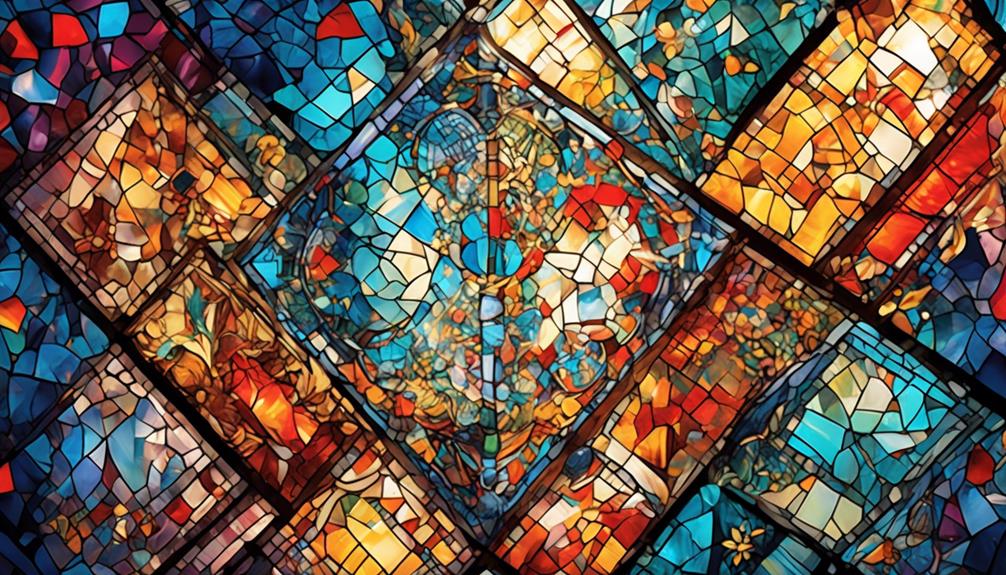Exploring the distinct qualities of stained glass and mosaic art forms enriches our understanding of their aesthetic and historical significance.
Stained glass, known for its vibrant colors achieved through variously colored glass pieces, is often associated with window art in churches and significant buildings.
Mosaics, on the other hand, create intricate designs using small pieces of glass, stone, or other materials, offering a different kind of visual complexity and texture.
Both require precise techniques and artistic vision, yet they differ in their execution and the effects they produce in light and space.
This concise comparison highlights their unique contributions to the art world.
Key Takeaways
- Stained glass and mosaic art have ancient origins and have been used throughout history for storytelling and cultural expression.
- Stained glass involves creating colored windows and artworks using glass pieces, while mosaic art uses small pieces of glass, stone, or other materials to create intricate patterns or images.
- Both techniques require skill, patience, and attention to detail.
- Stained glass and mosaic art offer stunning aesthetics and artistic compositions, with vibrant colors and intricate designs that captivate viewers.
History and Origins
The history and origins of mosaic art can be traced back to ancient civilizations, such as the Romans and Byzantines, who skillfully arranged small pieces of materials like stone, glass, and ceramics to create intricate designs. These early mosaic artworks weren't only decorative but also served as a means of storytelling and cultural expression.
The Romans, in particular, were known for their elaborate mosaic floors, which depicted scenes from mythology, daily life, and important historical events. The Byzantines, on the other hand, used mosaic art to adorn their churches and palaces, creating stunning religious imagery.
While mosaic art has a rich history, stained glass also has its own unique origins. Stained glass gained prominence in medieval Europe, where it was used to create intricate windows in churches and cathedrals. The process of creating stained glass involves assembling colored glass pieces using lead came or copper foil. This art form became a defining feature of medieval architecture, especially in religious contexts. Stained glass windows often depicted religious scenes and narratives, serving as a visual representation of the stories and teachings of the church.
Both stained glass mosaics and traditional mosaic art have cultural and historical significance. Mosaic art has been used in various cultures throughout history for decorative and narrative purposes, while stained glass became synonymous with medieval architecture and religious symbolism.
The intricate designs and vibrant colors of stained glass mosaics and traditional mosaic art continue to captivate and inspire people today, showcasing the skill and creativity of ancient civilizations and their enduring legacy in the world of art.
Materials and Techniques
To understand the materials and techniques used in both stained glass and mosaic art, it's important to delve into the intricate processes employed by artists.
Stained glass projects involve the creation of beautifully colored windows and artworks using pieces of glass, while mosaic projects involve the creation of intricate patterns or images using small pieces of glass, stone, or other materials.
Both techniques require skill, patience, and attention to detail.
In stained glass, artists typically start by creating a design or pattern on a piece of paper. The design is then transferred onto a full-sized drawing called a cartoon. Next, the artist selects and cuts the pieces of glass to fit the design. The pieces are then carefully assembled using lead came or copper foil, and the joints are soldered together. Finally, the stained glass is cleaned and polished to enhance its beauty.
On the other hand, mosaic art involves a different process. Artists begin by creating a design or pattern on a surface, such as a wooden board or a concrete wall. They then carefully arrange and adhere small pieces of glass or other materials to create the desired image or pattern. Once the pieces are in place, a grout is applied to fill the gaps and secure the pieces in position. The mosaic is then cleaned and sealed.
Both stained glass and mosaic art require precision and attention to detail. The techniques used in each process yield unique and stunning results. Whether you choose to create a stained glass masterpiece or a mosaic masterpiece, the materials and techniques employed will allow you to express your creativity and create a beautiful piece of art.
Aesthetics and Design

With their unique color palettes, intricate patterns, and design flexibility, both mosaic and stained glass art captivate viewers with their stunning aesthetics and artistic compositions.
The aesthetics and design of stained glass and mosaic play a crucial role in creating visual impact and evoking emotions. Both art forms utilize color palettes to create captivating visuals, but they do so in different ways.
Mosaic art provides a diverse range of colors by utilizing various materials such as glass, ceramic, or stone tiles. This allows for intricate and detailed designs, as the smaller tile pieces can be arranged to create complex patterns.
On the other hand, stained glass art relies on the vibrant hues and textures of colored glass to create its visual impact. The use of different colored glass pieces allows for the creation of vibrant and colorful designs, often depicting religious or narrative scenes.
Another aspect that contributes to the aesthetics of both stained glass and mosaic is the patterns. Mosaic art allows for intricate and detailed designs due to the smaller tile pieces, which can be arranged in various patterns to create visually stunning compositions.
Stained glass art also utilizes patterns, but in a slightly different way. The use of different colored glass pieces allows for the creation of patterns within the design itself, adding depth and visual interest.
In terms of design flexibility, both stained glass and mosaic offer unique advantages. Mosaic art provides flexibility in creating intricate designs using various materials, allowing artists to express their creativity and skill.
The versatility of stained glass, on the other hand, lies in its ability to depict various subjects with different colored glass pieces. This makes it suitable for a wide range of artistic expressions, from religious and narrative scenes to abstract designs.
Durability and Maintenance
As we shift our focus to the subtopic of durability and maintenance, it is important to consider how both stained glass and mosaic art require different levels of care to ensure their long-lasting beauty and structural integrity. Mosaic art, known for its durability, utilizes materials such as glass, ceramic, and natural stone, making it resistant to wear and tear. This durability translates to minimal maintenance requirements, allowing mosaic art to retain its vibrant appearance with little effort. On the other hand, stained glass art, while also durable, necessitates careful maintenance to prevent damage caused by environmental factors. To ensure the longevity of stained glass art, regular cleaning with a non-abrasive cleaner is recommended. Additionally, handling stained glass art with care is crucial to avoid breakage, and periodic inspections should be conducted to detect any signs of deterioration. Both stained glass and mosaic art should be shielded from extreme weather conditions, direct sunlight, and physical impact to prolong their lifespan and structural integrity.
Durability and Maintenance Comparison:
| Aspect | Stained Glass | Mosaic Art |
|---|---|---|
| Durability | Requires careful maintenance to prevent damage from environmental factors. | Known for its durability due to the use of materials like glass, ceramic, and natural stone. |
| Maintenance | Gentle cleaning with a non-abrasive cleaner. Periodic inspection for signs of deterioration. | Regular cleaning with a mild detergent and soft cloth. Regrouting if necessary. |
| Protection | Shield from extreme weather conditions, direct sunlight, and physical impact. | Shield from extreme weather conditions, direct sunlight, and physical impact. |
Frequently Asked Questions
Is Stained Glass a Mosaic?
Stained glass is not a mosaic, but it can be used to create mosaic-like designs. It has a rich history, with techniques like lead came and copper foil. Famous examples include the Notre-Dame Rose Window. Symbolism is often incorporated into stained glass designs.
What Is the Difference Between Art Glass and Stained Glass?
Art glass techniques encompass a wide range of glassworking methods, including stained glass. Stained glass has a rich history dating back centuries and is often associated with famous windows and contemporary glass artists.
What Is the Difference Between Colored Glass and Stained Glass?
Colored glass refers to glass that has been tinted or painted with various colors. Stained glass, on the other hand, is a specific technique of crafting colored glass by using lead strips to create intricate designs. The history of stained glass dates back centuries and it has been used in religious buildings as well as in decorative art pieces. In contemporary times, stained glass is still used in churches and cathedrals, but it has also found its place in modern architecture and interior design. The techniques used in stained glass involve cutting and shaping the glass pieces, and then soldering them together to create the final design. The result is a beautiful and vibrant piece of glass art that can add a unique touch to any space.
What Is Mosaic Glass Called?
Mosaic glass, also known as glass tesserae, is the material used in creating mosaic art. It has a long history, with Byzantine mosaics being famous examples. Today, contemporary mosaic art continues to showcase the beauty and versatility of this medium.
